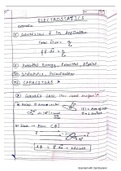Interview
Class notes and competitive exam level problem solving of electrostatics[all concepts]
- Course
- Institution
- Book
Electrostatics chapter made easy! Helped me understand concepts in depth. Basics to advance problem solving with important tips and tricks to remember. Highlighted notes and diagrams to clear the concept once and for all.
[Show more]




